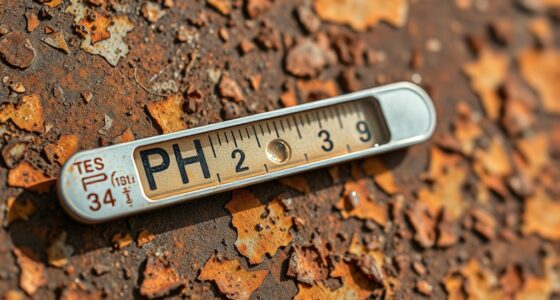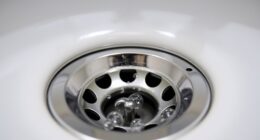To understand a water quality report, start with the cover page to see sampling locations and water source info. Next, review the list of tested contaminants and their levels, comparing them to safety standards like EPA limits. Pay attention to warning signs if levels are high, and learn what sources might be causing issues. Knowing these basics helps you decide if your water is safe and what steps to take. Keep exploring for detailed insights.
Key Takeaways
- Understand the cover page for sampling locations, water source, and treatment details.
- Review contaminant levels and compare them to safety standards and regulatory limits.
- Identify if contaminant concentrations exceed safe or warning thresholds.
- Determine the potential sources and health risks associated with detected contaminants.
- Ask questions about measurement methods, detection limits, and follow-up actions if needed.
Understanding the Cover Page and General Information
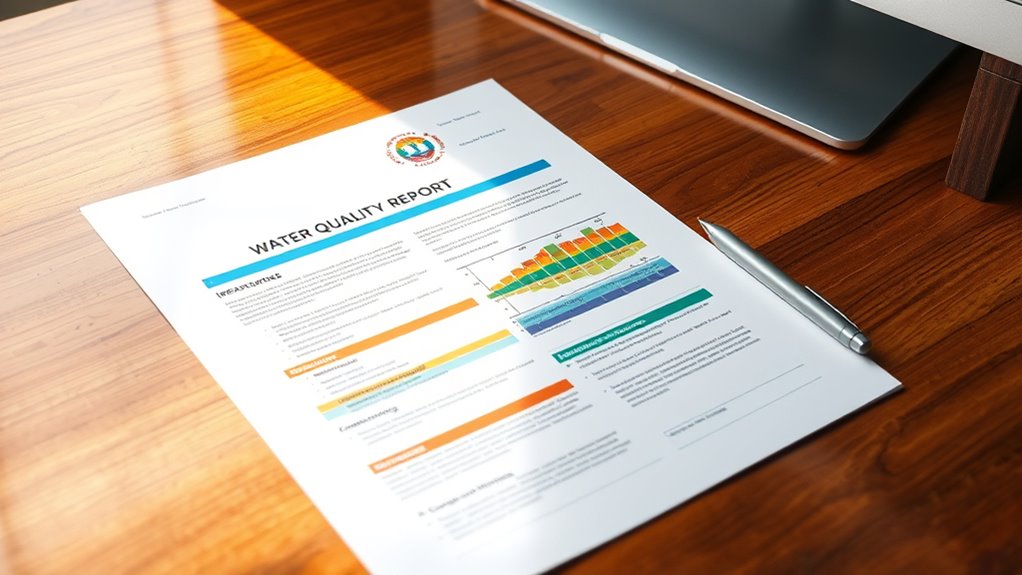
Have you ever wondered what the cover page of a water quality report tells you? It provides essential details about your water supply, starting with sampling locations. These locations show where tests were conducted, helping you understand which parts of your water system were checked. The cover page also highlights water treatment processes, giving you insight into how your water is purified before reaching your tap. Typically, you’ll find the report’s date and contact information for your water utility, so you know how recent the data is and where to ask questions. This page sets the stage for understanding the rest of the report, ensuring you grasp where the water comes from, how it’s treated, and what areas were tested. Reviewing water treatment methods can help you better understand the filtration and purification steps involved in maintaining water quality.
Deciphering the Contaminant List and Levels
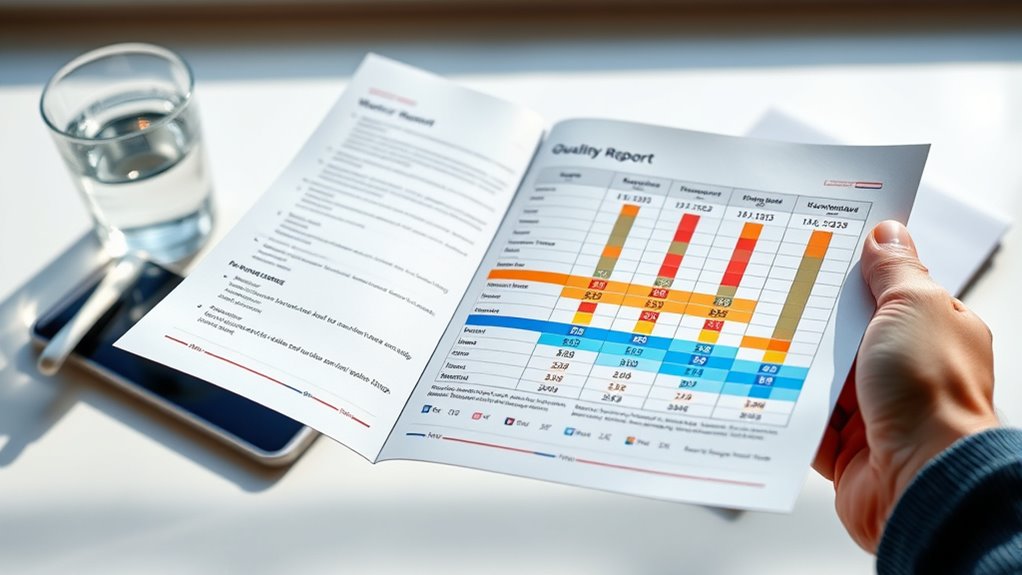
The contaminant list in your water quality report identifies the substances tested for in your water supply, including both naturally occurring and man-made pollutants. You’ll see contaminant concentrations listed, showing how much of each substance is present. Understanding these levels helps you assess potential health implications. Higher concentrations may indicate a greater risk, especially if they exceed safety standards. Pay attention to the units of measurement, usually parts per million (ppm) or parts per billion (ppb), to gauge the severity. Remember, even low levels can matter if a contaminant is harmful at small doses. By comparing the listed levels to regulatory guidelines, you can better understand whether your water poses any health concerns. Recognizing the technologies used in air purification, such as HEPA filters or activated carbon, helps you choose the most effective solutions for your needs. This step is vital for making informed decisions about your water safety.
Recognizing Safe vs. Warning Levels

How can you tell if contaminant levels in your water are safe or pose a warning? First, check the report’s allowed limits, like lead thresholds, which protect your health. Second, look for pesticide contamination levels—if they exceed safe standards, it’s a red flag. Third, pay attention to any readings labeled as “warning” or “above the permissible limit.” Fourth, trust your instincts—if something seems off, don’t ignore it. Water with pesticide contamination or lead levels above safety thresholds can cause serious health issues. Recognizing these warning signs helps you stay informed and proactive. Always compare contaminant levels to the EPA’s standards, and remember, safe levels are set to keep you and your family healthy. Ignoring warning levels puts you at unnecessary risk. Understanding water safety standards is essential for making informed decisions about your water quality.
Interpreting the Sources and Possible Risks
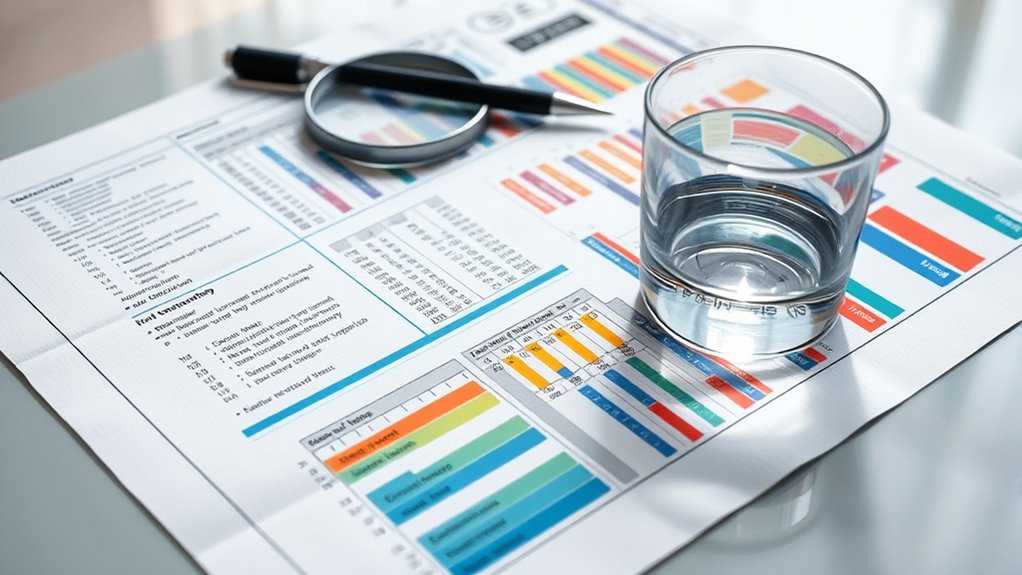
Understanding where contaminants come from helps you assess their potential risks. Source identification is key in this process—knowing whether pollutants originate from natural sources, industrial activities, or aging infrastructure helps you evaluate their severity. For example, lead may stem from old pipes, while pesticides often come from agricultural runoff. Once you identify the sources, conduct a risk assessment to determine how these contaminants might affect your health. Consider factors like concentration levels and exposure frequency. Some sources pose minimal risk, while others can cause serious health issues. By understanding the origins of contaminants, you gain insight into how to protect yourself and your family, making informed decisions about water safety and necessary actions.
What Do the Symbols and Terms Mean?
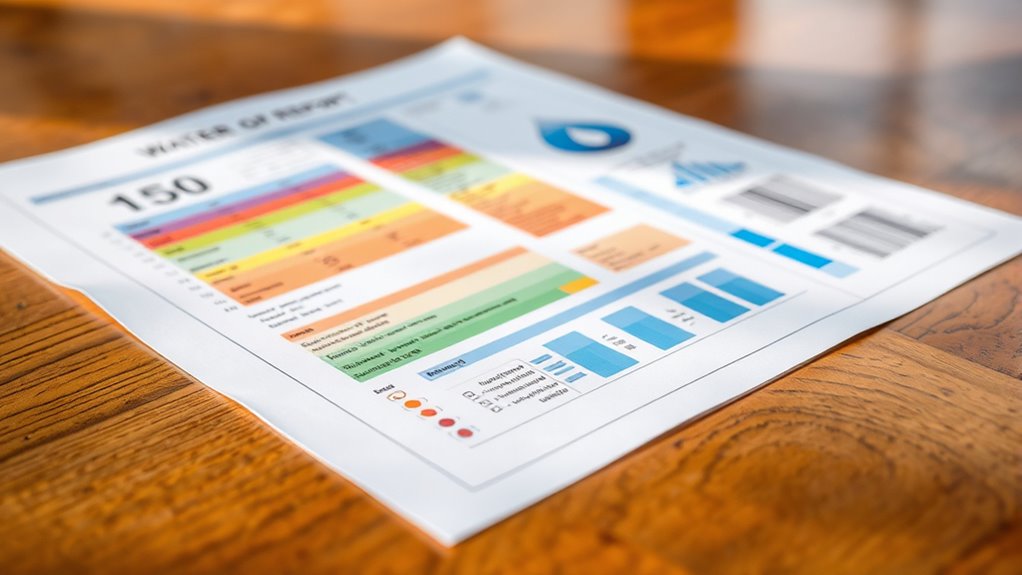
Have you ever looked at a water quality report and found yourself confused by the symbols and technical terms? Don’t worry—it’s common. When you see contaminant symbols, they represent specific substances detected during water testing. Understanding these symbols helps you grasp what’s in your water. Here are key points to clarify this:
- Unit of measurement: Shows how much of each contaminant is present.
- Detection limits: Indicates the smallest amount that can be identified through testing.
- Contaminant symbols: Short codes or abbreviations for chemicals, bacteria, or metals.
- Action levels: The safety threshold; if exceeded, it signals potential health risks.
Familiarity with these terms ensures you truly understand your water’s quality and safety. Additionally, understanding AI in Business can help interpret complex data and reports more effectively.
Identifying Actionable Items and Recommendations
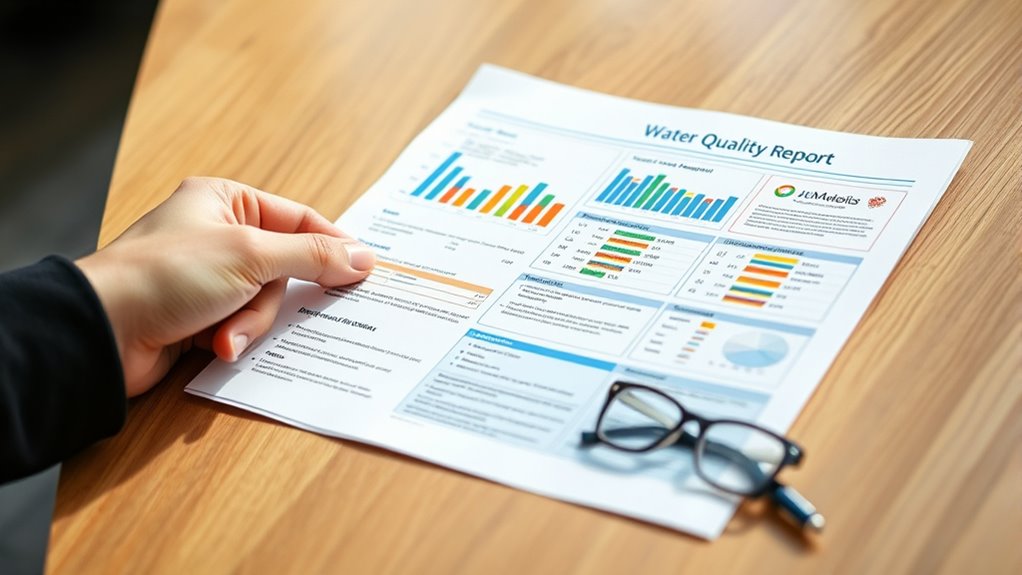
When reviewing a water quality report, it is vital to identify actionable items and recommendations that can protect your health. Look for suggestions on water treatment options or household filters to reduce contaminants. These steps directly impact public health by minimizing exposure to harmful substances. Consider whether the report indicates elevated levels of certain pollutants and if immediate action is needed. Use the table below to help interpret recommendations:
| Action | Why It Matters | Next Step |
|---|---|---|
| Install a filter | Removes specific contaminants | Research suitable filters |
| Use bottled water | When tap water exceeds safe limits | Purchase trusted brands |
| Regular testing | Ensures ongoing safety | Schedule periodic tests |
| Maintain plumbing | Prevents buildup of pollutants | Schedule inspections |
Being aware of water quality standards helps you better understand the significance of the report’s findings. Identifying these actionable items helps you safeguard your water and public health effectively.
Comparing Your Results to Regulatory Standards
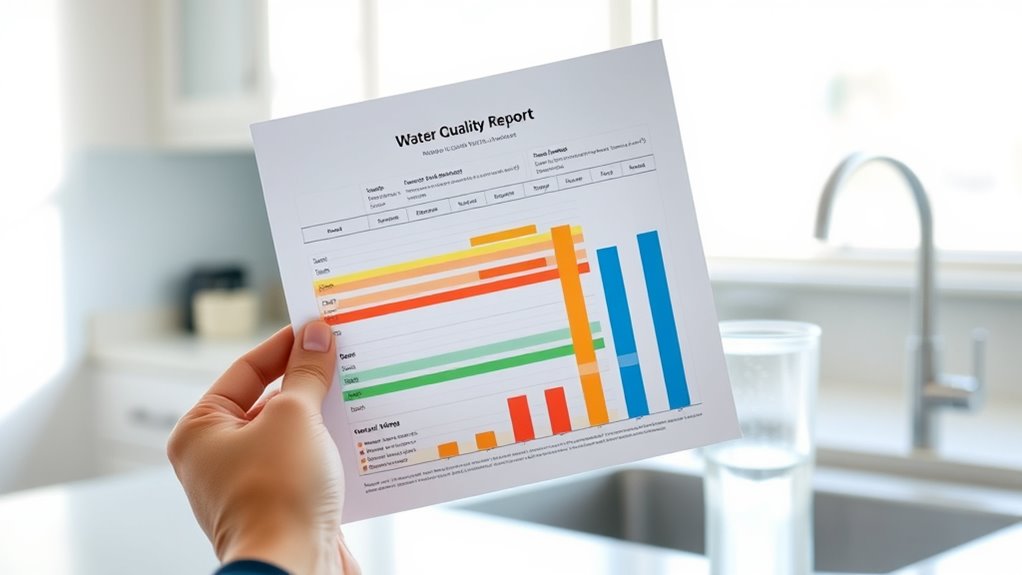
Understanding regulatory limits helps you know if your water is safe. You’ll learn how safe levels differ from unsafe ones and what triggers concern. This knowledge allows you to interpret your results confidently and take appropriate action if needed. Recognizing water quality standards is essential to assess whether tuning modifications or upgrades are within safe parameters.
Regulatory Limits Explained
How do your water test results compare to the regulatory limits set by authorities? These limits are designed to protect your water safety, making sure contaminants stay within safe levels. Understanding these standards can be empowering and reassuring. Here are key points to think about:
- Regulatory limits act as a safety barrier, shielding you from harmful pollutants.
- Testing accuracy is vital—trust certified labs to provide precise results.
- Exceeding limits signals potential risks, prompting action to protect your health.
- Compliance ensures peace of mind, confirming your water meets safety standards.
- Regularly reviewing pinball machine regulations can help ensure your testing methods align with current safety standards.
Knowing how your results relate to these limits helps you assess water safety confidently and take necessary steps if levels are high. Accurate testing and understanding regulatory standards are your best tools for safe drinking water.
Safe vs. Unsafe Levels
Are your water test results safe to drink? Comparing your results to regulatory standards helps determine if your water is safe or unsafe. Water pollution can introduce contaminants that exceed safe levels, making water testing essential. Check your report for contaminant levels, and see how they stack up against established limits. Here’s a quick comparison:
| Contaminant | Regulatory Limit | Your Result |
|---|---|---|
| Nitrate | 10 mg/L | 8 mg/L |
| Lead | 15 μg/L | 20 μg/L |
| Arsenic | 10 μg/L | 9 μg/L |
| Total Coliform | None detected | Detected |
If results surpass limits, your water could be unsafe. Regular water testing helps spot issues caused by water pollution early, ensuring safe drinking water. Understanding water quality is crucial for maintaining health and safety.
Action Thresholds Clarified
Knowing whether your water results require action depends on how they compare to regulatory thresholds. These action thresholds are set to protect your health by indicating when contaminant levels are too high. If your results exceed these thresholds, it’s a sign that your water could pose a health impact.
Consider these points:
- Surpassing action thresholds means your water might harm your health.
- Staying below thresholds doesn’t guarantee safety but reduces risks.
- Regulatory standards are designed to keep your water safe for daily use.
- Understanding these limits empowers you to take control of your water quality.
Always compare your results to these standards to determine if action is necessary—your health depends on it.
Tips for Asking Questions and Taking Next Steps

When you have questions about your water quality report, don’t hesitate to ask for clarification on measurement methods or specific results. Planning your next steps, like testing again or contacting experts, helps you stay informed and proactive. Taking these actions guarantees you understand your water safety and can address any concerns effectively. Recognizing air quality factors that affect your environment can also support your efforts to improve overall health.
Clarify Measurement Details
Wondering how to get clear answers about your water quality report? Start by asking about measurement details. Knowing the measurement units helps you understand what the numbers truly mean. Clarify the detection limits to see if contaminants are present but below measurable levels — this can reassure you or highlight areas for concern. To dig deeper, consider these steps:
- Ask which measurement units are used for each contaminant.
- Inquire about the detection limits to understand the report’s sensitivity.
- Request explanations if numbers seem confusing or inconsistent.
- Confirm whether the results are within safe standards or if further testing is needed.
Getting clear answers on these measurement details empowers you to interpret your report accurately and make informed decisions about your water quality.
Plan Follow-Up Actions
Once you’ve clarified the measurement details in your water quality report, the next step is to plan your follow-up actions. A report follow-up involves deciding whether your water needs further testing or improvements. If contaminants or issues are identified, consider scheduling additional water testing to confirm the problem and determine its severity. Don’t hesitate to ask questions—contact your water supplier or local health department for clarification on results and recommended steps. If testing shows unsafe levels of pollutants, you may need to explore treatment options or switch to a safer water source. Staying proactive ensures you protect your health. Keep records of all communication and testing results, so you’re prepared for future assessments and can make informed decisions. Additionally, understanding water contaminants can help you better interpret your water quality report and advocate for necessary improvements.
Frequently Asked Questions
How Often Should I Review My Water Quality Report?
You should review your water quality report annually to stay informed about water testing results and guarantee contamination prevention. Regular checks help you catch any issues early and maintain safe water standards. If your water source has recent changes or if local advisories are issued, review the report more frequently. Staying proactive protects your health and ensures your water remains clean and safe for your household.
Can Water Quality Vary Between Different Locations in My Home?
Yes, water quality can vary between different locations in your home. Factors like kitchen filtration may improve water taste and safety at the sink, while plumbing materials, such as old pipes, can introduce contaminants elsewhere. You should regularly check water quality at multiple points, especially if you notice changes in taste, smell, or appearance. Installing filters and upgrading plumbing can help guarantee consistent, clean water throughout your home.
What Health Symptoms Indicate Water Contamination?
If your water is contaminated, you might notice health symptoms like nausea, vomiting, diarrhea, or stomach cramps. Skin rashes or irritation can also occur, especially after bathing or washing. Stay alert to health alerts and symptom awareness, as these signs could indicate unsafe water. If you experience these symptoms, stop using the water and seek medical advice. Regular testing helps identify contamination early, protecting your health and well-being.
Are Private Wells Subject to the Same Reporting Standards?
Private wells aren’t subject to the same reporting standards as public water systems. You’re responsible for understanding private well regulations and meeting testing requirements. Regular testing for contaminants like bacteria, nitrates, and other pollutants is essential to guarantee your water remains safe. Keep records of tests and follow recommended schedules, so you can detect issues early and address them before health symptoms appear.
How Can I Improve Water Quality if Contaminants Are High?
When contaminants are high, you can improve water quality through contaminant mitigation by installing effective filtration options. Start by identifying the specific pollutants in your water report, then choose filters like activated carbon, reverse osmosis, or UV systems tailored to eliminate those contaminants. Regular maintenance and testing ensure your system keeps working well, giving you cleaner, safer water straight from your tap.
Conclusion
By mastering the methods of measuring, matching, and monitoring, you’ll move from muddled meaning to mindful mastery of water quality. With clear comprehension, you can confidently compare, question, and conquer concerns. Remember, reading your report isn’t just a routine—it’s a powerful practice to protect your peace and purity. Embrace these essential steps, and transform your tap’s tale from troubling to trustworthy, turning your water worries into wise, well-informed decisions.





